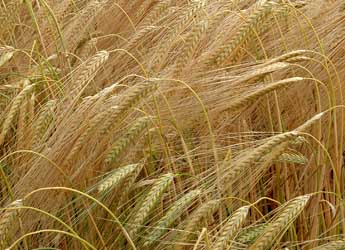Scotland, United Kingdom
November 20, 2012
How was barley, a plant native to the Middle East and South-Western Asia, able to grow all over the UK and become Scotland’s main arable crop? The answer lies in the combined forces of evolution and selection, according to an article published by a scientific team from the James Hutton Institute in the journal Nature Genetics.

In research that could have significant implications for the ability of breeders and farmers to respond to our changing climate and ensure food security, the Scottish researchers – along with colleagues in Germany and Italy – highlight the potential benefits of understanding the huge natural diversity that is found in collections of crop plants and their close relatives.
Wild barley comes originally from the region called the Near East Fertile Crescent (present-day Egypt, Israel, Syria, Jordan, Iraq and Iran). There, after a hot dry summer, barley seeds germinate with the first autumn rains, using the residual heat of summer and the newly available moisture to establish vegetative growth before winter sets in. The cold of winter then provides a signal within the plant that programmes it to grow, flower and set seed in early spring before the crippling heat of summer once again begins.
However, as barley was carried by ancient farmers and traders as they migrated west and then north into temperate climates, this ‘lifestyle’ became less ideal. Over time barley evolved into a crop that could be planted in the spring, allowing it to avoid the ravages of harsh northern European winters and benefit from the long cool days of summer, finally maturing in early autumn.
Using the latest genetic approaches, the international team identified highly characteristic ‘signatures’ on the barley genome that differentiate the ancestral ‘winter’ from the derived ‘spring’ lifestyle. Focussing specifically on one of these signatures they identified a highly specific genetic change that alters the function of a single gene in spring planted varieties. The change makes spring crops flower and set seed much later than their ancestors, allowing them to grow longer and convert more sunlight into harvestable yield.
Professor Robbie Waugh, leader of the research effort, commented: "Understanding the natural adaptations that have occurred in the genes and genomes of crop plants as they encountered new environments – and eventually flourished in them – is especially important as we face the uncertainty of climate change and the need to maintain crop yields.
"Knowing each of the genes responsible will help breeders tailor new varieties of barley, and possibly its close relative wheat, to emerging climate scenarios in the UK, but also to more marginal environments as cropping areas are forced to expand to tackle the challenge of food security."
Professor Waugh and the James Hutton Institute also led the UK effort in the international consortium of scientists responsible for a high resolution draft of the barley genome, which will help to produce new and better barley varieties that are vital for the food, beer and whisky industries.
Paper:
Natural variation in a homolog of Antirrhinum CENTRORADIALIS contributed to spring growth habit and environmental adaptation in cultivated barley.
Nature Genetics, 18 November 2012.
Professor Robbie Waugh is a leading crop geneticist based at the James Hutton Institute. His main research interests is to develop and apply state of the art genomics technologies to investigate the genetic control key traits in barley and potatoes, two major Scottish crops. He plays a significant role in national and international organisations that promote and co-ordinate global research on wheat and barley including Monogram, the International Triticeae Mapping Initiative and the European Triticeae Genomics Initiative. He also works closely with the Division of Plant Sciences, University of Dundee.
The James Hutton Institute was formed in 2011 by the Macaulay Land Use Research Institute in Aberdeen and SCRI, the Scottish Crop Research Institute based in Invergowrie near Dundee, Scotland. The Institute encompasses a distinctive range of integrated, world-class strengths in land, crop, water, environmental and socio-economic science. It undertakes a wide range of research for customers including the Scottish and UK Governments, the EU and other organisations worldwide. The institute has a staff of nearly 600 and 150 PhD students.
The Institute organises its research through seven principal themes: Safeguarding Natural Capital, Enhancing Crop Productivity and Utilisation, Delivering Sustainable Production Systems, Controlling Weeds, Pests and Diseases, Managing Catchments and Coasts, Realising Land’s Potential and Nurturing Vibrant and Low Carbon Communities. The Institute takes its name from the 18th century Scottish Enlightenment scientist, James Hutton, who is widely regarded as the founder of modern geology and who was also an experimental farmer and agronomist.